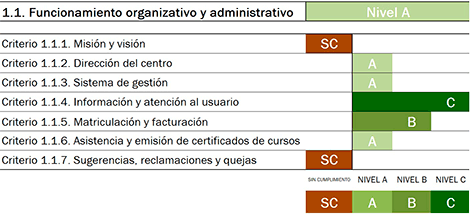Scoring criteria
SACIC's scoring system
To obtain a favourable Technical-academic report in the SACIC assessment, it is necessary to:
- Comply with all of the descriptors associated with the minimum prerequisites (referred to as Criterion 0).
- Obtain at least a level-A assessment in each of the 10 sections of the SACIC Assessment Framework. One exception is allowed: one of the five sections of the “teaching and learning services” area may receive a "non-compliance" assessment. In this case, the negative assessment must be offset by an assessment higher than level A (level B or C) in one of the other four sections of the area.
- Obtain at least a level-A assessment in “Criterion 1.2.4. Consolidation of teams”, from section “Teams and individual staff”.
- For renewals entailing a Model 1 assessment, proof must be provided of the total or partial implementation of 60% of the actions set forth in the improvement plan presented during the previous assessment.
Once these prerequisites have been met, the centre’s final assessment score shall be the average score of the assessment of each section.
The assessment score of each section is calculated based on the score that the centre receives for the SACIC Assessment Framework criteria, which are as follows:
SACIC Assessment Framework Internal organization | Criteria for the assessment of Accredited Centres | |
|---|---|---|
| SACIC Assessment Framework. Internal organization into assessment areas, sections and criteria. | ||
| Areas | Sections | Criteria |
| 1. Organization and administration of the centre | 1.1. Organization and administration | Criterion 0. Minimum prerequisites associated with the section Section-specific criteria
|
| 1.2. Teams and individual staff | Criterion 0. Minimum prerequisites associated with the section Section-specific criteria
|
|
| 2. Teaching and learning services | 2.1. Academic planning | Criterion 0. Minimum prerequisites associated with the section Section-specific criteria
|
| 2.2. Courses and classes | Criterion 0. Minimum prerequisites associated with the section Section-specific criteria
|
|
| 2.3. Assessment of students | Criterion 0. Minimum prerequisites associated with the section Section-specific criteria
|
|
| 2.4. Student guidance and monitoring | Criterion 0. Minimum prerequisites associated with the section Section-specific criteria
|
|
| 2.5. . Coordination of academic activities | Criterion 0. Minimum prerequisites associated with the section Section-specific criteria
|
|
| 3. Supplementary services | 3. Supplementary services | Criterion 0. Minimum prerequisites associated with the section Section-specific criteria
|
| 4. Teaching and learning facilities and resources | 4. Teaching and learning facilities and resources | Criterion 0. Minimum prerequisites associated with the section Section-specific criteria
|
| 5. Information and publicity about the centre and its services | 5. Information and publicity about the centre and its services | Criterion 0. Minimum prerequisites associated with the section Section-specific criteria
|
The assessment assigns one of four possible levels, considering the specific criteria of each section:
Level A |
Level B |
Level C |
|
| SACIC Assessment Framework. Levels of compliance with accreditation criteria. | |||
Non-compliance |
Basic compliance with the accreditation criteria |
Advanced compliance with the accreditation criteria |
Coherent, substantiated and systematic compliance with the accreditation criteria |
The process to determine compliance with each criterion enables the centre to provide evidence relevant to its particular circumstances, for the descriptors associated with each level.
The proportion of A and B descriptors that are associated with the different score levels is specified in the assessment forms that the centres receive when they engage the services of an assessment entity. In addition to complying with all or almost all of the criterion descriptors, to obtain a level C assessment, centres must be able to provide evidence of the substantiation and systematization of the practices analysed in each case.
The centre’s score for each section is the average score received in the assessment of each criterion. To obtain a level-A score for each section, the system requires that the centres obtain level-A scores on at least 60% of the section criteria, or that they can offset an unfavourable result ("Non-compliance") for one or more criteria with others on which they have obtained a level-B or level-C score. Moreover, in the “teams and individual staff” section, the centres must obtain a level-A score on criterion “1.2.4. consolidation of teams.”

The advantages of this scoring system are as follows:
- It is flexible. Except for the Criterion 0 descriptors (minimum prerequisites), which are all mandatory, the centres have a certain margin when it comes to establishing the level of compliance with the criterion that is appropriate to its particular circumstances. They may also decide that it is not necessary for them to meet all of the SACIC Assessment Framework criteria in order to undertake their specific project.
- It proposes a roadmap for the centre’s advancement. The assessment score for each criterion and section is not made public. SACIC offers this assessment to the centres solely to enable them to make steady progress in improving their activities and services.